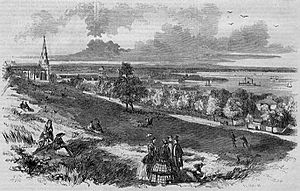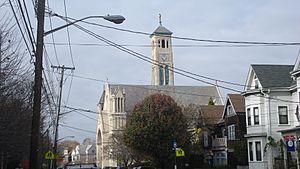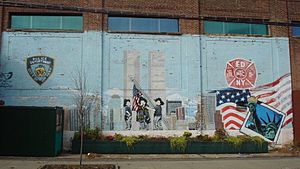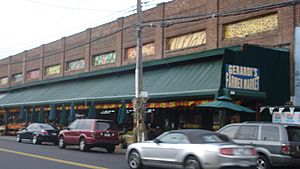New Brighton, Staten Island facts for kids
Quick facts for kids
New Brighton
|
|
|---|---|
|
Neighborhood of Staten Island
|
|

View of Brighton, Staten Island, New York, an 1857 engraving
|
|
| Country | |
| State | |
| City | |
| Borough | |
| Community District | Staten Island 1 |
| Area | |
| • Total | 0.93 km2 (0.361 sq mi) |
| Population
(2011)
|
|
| • Total | 5,795 |
| • Density | 6,198/km2 (16,053/sq mi) |
| Economics | |
| • Median income | $49,807 |
| ZIP Codes |
10301
|
| Area code | 718, 347, 929, and 917 |
New Brighton is a neighborhood located on the North Shore of Staten Island in New York City. The neighborhood comprises an older industrial and residential harbor front area along the Kill Van Kull west of St. George. New Brighton is bounded by Kill Van Kull on the north, Jersey Street on the east, Brighton and Castleton Avenues to the south, and Lafayette Avenue and Snug Harbor Cultural Center to the west. It is adjacent to St. George to the east, Tompkinsville to the south, and West New Brighton to the west.
The village of New Brighton was incorporated in 1866 out of six wards of the town of Castleton. It originally stretched four miles (6.4 km) long and was two miles (3.2 km) wide, encompassing the entire northeast tip of the island from Tompkinsville to Snug Harbor, and included what is now St. George. The current neighborhood includes Hamilton Park, an enclave of Victorian homes built before the American Civil War. The surrounding area includes several older churches such as St. Peter's Church, the oldest Roman Catholic church on Staten Island. The original New Brighton Village Hall, constructed in 1871 on present Fillmore Street, was demolished in 2004. New Brighton public housing includes the Cassidy-Laffayette Houses and the Richmond Terrace Houses on Jersey Street.
New Brighton is part of Staten Island Community District 1 and its ZIP Codes are 10304 and 10301. New Brighton is patrolled by the 120th Precinct of the New York City Police Department.
Contents
History
Village Hall
Built in 1871, the New Brighton Village Hall was one of the few Village Halls to remain from the old village system the existed before it was considered to be a part of New York City. In 1898, the villages were incorporated into New York City and the Village Halls were no longer needed as politics became more centralized into the city and they became just one of many under the borough of Staten Island. It has since been used as a local court, a health insurance office, youth activities office, and doctor’s office. In 1965 the Landmarks Preservation Commission selected it as an official landmark. It was demolished in 2004.
Incorporation of New Brighton
A passage from an anonymous author in an Illustrated Sketch Book of Staten Island, NY: Its industries and commerce, from 1886, describes New Brighton as follows:
The village of New Brighton is unique in its attractiveness. Its public buildings, churches, hotels and institutions are all handsome and substantial, its residences the perfection of refined taste; it has fifteen miles (24 km) of streets, the principal of which are wide, well paved, and generally well shaded with ornamental trees. A complete system of sewerage has been adopted. The inhabitants are filled with a sense of local pride which is in itself most commendable and leads to the happiest results, the most noticeable of which perhaps is the great care bestowed upon their private residences. The neighbors seem to vie with each other in friendly emulation as to who shall keep the smoothest lawn, the neatest fence or the most graceful fountain.
As a whole, the effect is most pleasing, but when the eye wanders beyond the artificial beauty of its immediate surroundings and rests upon the sparkling waters of the incomparable Bay of New York, with stretches of cultivated landscape in the distance, the picture is singularly lovely and complete.
Although Staten Island as a whole remained largely residential and less densely populated and developed than the surrounding region, the inhabitants of the region favored consolidation with the greater metropolis. In 1898, Staten Island was consolidated with New York City, and this move accelerated development of the region. At this time immigrant groups settled in New Brighton in greater numbers; Italians and African-Americans along the Kill Van Kull, and Jewish communities on the eastern boundary of the village near St. George and Tompkinsville.
20th century
After the turn of the century, the political and economic center of the island shifted to the northern shore, including New Brighton. The construction of a new civic center and borough hall in St. George provided the impetus for improvements in infrastructure, including road construction, police and fire protection, and two commuter airports, each of which were first established in the 20th century. Navy and Coast Guard outposts could be found on the north shore of Staten Island, each employing local residents in military and civilian capacities. The Staten Island borough hall was built in 1906, while the new courthouse for Richmond county was built in 1919.
At this time, the general community of Staten Island and New Brighton thrived due to its economy. Larger manufacturers employed many local residents; Procter & Gamble, US Gypsum, and several other factories provided jobs for thousands of residents. The Procter & Gamble factory, opened in October 1907, operated for more than 80 years. At the end of the 1920s, some of the borough’s first apartment buildings and four-family dwellings were concentrated in New Brighton.
However, the livelihood of the community began to change, first after the completion of the Verrazano-Narrows Bridge, and compounded by the economic downturn of the 1970s. The Verrazano-Narrows Bridge, completed in November 1964, connected Brooklyn and Staten Island and allowed for a massive population and development boom that continues to this day. This, combined with the closing of many area factories, the construction of housing projects along Richmond Terrace and the surrounding area, and an increase in area poverty, have created an area that has changed so drastically. While crime has increased to an extent in the area, New Brighton remains a vibrant neighborhood that contains many historic attractions, as well as a place of community that is dedicated to improving and reviving the area.
Attractions
In addition to the Building at One Pendleton Place and New Brighton Village Hall, the Christ Church New Brighton (Episcopal), Hamilton Park Community Houses, and Neville House are listed on the National Register of Historic Places.
Snug Harbor
Sailors' Snug Harbor was built in 1833 by a wealthy New Yorker named Robert Richard Randall. Designed as a place for retired sailors, Snug Harbor was the first establishment of its kind in the United States. The 83-acre (340,000 m2) park-like setting is located right on the north shore of Staten Island along the Kill Van Kull.
The original buildings in Snug Harbor were built in the elegant Greek revival style, but later buildings incorporated a variety of styles: Beaux Arts, Renaissance Revival, Second Empire, and Italianate styles. Notably, Captain Thomas Melville, the brother of Herman Melville (the author of Moby Dick), was the governor of Snug Harbor from 1867 to 1884.
Snug Harbor was very successful, and was one of the wealthiest charities. At its peak, 1,000 sailors made their home at Snug Harbor. However, there was a steep decline in funding for the retirement home in the 1930s, with the establishment of Social Security, and Snug Harbor never fully recovered, closeing in the 1960s. After the closure, there was competition for the land between developers and the locals who wanted to save the property. In the late 1960s, the newly formed New York City Landmarks Commission intervened, designating that site a Historic Landmark and laying the groundwork for converting the land into a cultural center for public usage.
The site is now called Snug Harbor Cultural Center and Botanical Gardens and has gardens, museums, theaters, educational spaces, and special events. It works in collaboration with the Smithsonian to bring a variety of unique programming to an underappreciated spot.
George Way, a contributor to the Museum and an expert in Dutch furniture, explained that Snug Harbor is a struggling gem that should be more successful. On a visit to the site, Mr. Way was there for the day checking in on his prominent period furniture exhibit, entitled "Dutch Treats," and he described his dedication to the location. A Staten Island resident, Mr. Way saved some special pieces to be displayed at Snug Harbor—even though his pieces are in high demand at a number of city museums, given 2009's importance as the 400th anniversary of Dutch explorer Henry Hudson's discovery of New York. Mr. Way exemplified the local camaraderie seemingly felt on the island for Snug Harbor and other culturally significant sites. One of the Center’s employees also discussed her passion for Staten Island and her hope that Snug Harbor could bring more success to the Island. While proudly wearing her Staten Island shirt, she expressed disappointment in Staten Island's inability to lure people out of the Ferry terminal, despite her confidence that Snug Harbor is an extraordinary historical site.
St. Peter's Church
The first weekly Mass of St. Peter's Roman Catholic Church was held in 1839 in an unlikely location: a gun factory in New Brighton. The original Catholic congregation was about 100 people. Unsurprisingly, the gun factory quickly became unsuitable for services, and the New Brighton Association donated land for the church. The new church opened in 1844, not far from where it is today on St. Mark's Place.
In 1853, the Sisters of Charity arrived and established a school in the church's basement that taught both boys and girls at a primary school level, as well as girls at the high school level. These classes were the foundations of the St. Peter's schools that continued operating for more than a century in New Brighton.
In 1891, Reverend Terrence J. Early arrived as the pastor for St. Peter's and decided that the church needed a larger building. He wanted the layout to be reversed while also making the entire church longer and wider. Without building an entirely new structure, he moved the main entrance onto St. Mark's Place. A fire destroyed the original building in the late 1890s, allowing for the current building to be constructed on the same spot. The new church, designed by the firm Harding and Gooch in the neo-Romanesque style, was directly overseen during construction by Reverend Early. The cornerstone was laid in 1900, and in 1902 construction began on the upper portion. During this time, the parishioners were forced to worship in the basement until the construction was completed in 1903.
The interior of the church has influence from the French-Gothic style, visible in its vaulted ceilings that are curved and end in a point at the top. This unique arch structure enables the ceilings to be made high without needing interior supports. Today, St. Peter's Church is a gorgeous building that can be seen from almost anywhere in New Brighton, and one that stands out while approaching Staten Island on the ferry.
W.S. Pendleton Houses
The W.S. Pendleton Houses at 1 & 22 Pendleton Place are designated landmarks of New York City. The Building at One Pendleton Place was listed on the National Register of Historic Places in 2014.
Built in 1861, One Pendleton Place was designed by Charles Duggin in the Stick style.
22 Pendleton Place was officially recognized by the New York Landmarks Preservation Foundation in 1989. Built in 1855, this Gothic Revival style house is a fine example of Victorian Romanticism. The structure possesses a distinctive individuality, with its square, spire-topped tower, steeply pitched gables, pendant scrollwork, asymmetrically placed dormers, bay windows and oriel.
Both houses were once owned by W.S. Pendleton, a prominent local businessman who worked in real estate and owned a local ferry boat company. Pendleton, born in New York City in 1795, later became a pioneer lithographer in Boston.
Creative Photographer's Guild
The Creative Photographer's Guild is a non-profit organization that creates beautiful and interesting photographic exhibits. It was formed in 2005 by a group of Staten Island photographers who wished to create an organization that went beyond that of the triditional camera club. Its mission is to encourage the understanding and appreciation of photography as a modern visual language and a true art form. In 2009 CPG Gallery was established. George Roos, co-founder and past president (2005–09) of the Guild, had been renting the space for use as his studio. Upon retirement he offered it to CPG for the purpose of creating the CPG Gallery. At present CPG Gallery is open on Saturdays and Sundays from 1-5 pm. The Gallery is located on Tyson St. right off Richmond Terrace, across from Snug Harbor Cultural Center. Approximately ten exhibits are held each year with openings for each exhibit.
Atlantic Salt Company
The Atlantic Salt Company is located along Richmond Terrace and stores salt that is used to remove ice from roads in New York, New Jersey, and Connecticut. Walking along Richmond Terrace, the many hills of white salt can be glimpsed along the side of the road. During the winter, over 350,000 tons of salt are stored at this New Brighton location. The Atlantic Salt Co. purchased its current location in 1976, a gypsum corporation plant owned and used the property. The Atlantic Salt Co. is family-run and operated by the Mahoney family; the first generation, headed by founder and former president Leo Mahoney, started the business in 1955. It has been successfully growing since then.
Atlantic Salt prides itself in taking a vested interest in improving the community. In August 2009, the company cleared out their miles of salt stockpiles in order to host a free celebration, giving back to the people of Staten Island. The company is also in the process of investing money along the shore to clean up and get rid of some of the buildings that are unable to be restored. The company has recently revealed plans to create a walking and biking path along Richmond Terrace, which would help create a path from the Staten Island Ferry to Snug Harbor, an important cultural site located right beyond the Atlantic Salt Company.
September 11 Memorial
This large mural, painted by a local artist who paints under the name FWID, adorns the side of the warehouse on Richmond Terrace where Gerardi's Farmer Market is located. The three firefighters raising the American Flag in the center of the image strike a pose that is reminiscent of the historic photograph Raising the Flag on Iwo Jima by Joe Rosenthal.
Farmer's Market
Gerardi's Farmer Market, a local market on Richmond Terrace. The market is a good place to stop by and pick up a snack on the way back to the ferry. The Farmer's Market carries fresh and local produce nearly year-round for the residents of New Brighton.
Transportation
New Brighton was served by the Staten Island Railway's New Brighton station until March 31, 1953, when the entire North Shore Branch was shut down. As of 2019[update], it is served by the S40, S42, S44, S46, S52, S90, S94, S96 local bus routes.
Demographics
For census purposes, the New York City government classifies New Brighton as part of a larger neighborhood tabulation area called West New Brighton-New Brighton-St. George. Based on data from the 2010 United States Census, the population of West New Brighton-New Brighton-St. George was 33,551, a change of 1,397 (4.2%) from the 32,154 counted in 2000. Covering an area of 1,403.06 acres (567.80 ha), the neighborhood had a population density of 23.9 inhabitants per acre (15,300/sq mi; 5,900/km2). The racial makeup of the neighborhood was 26.4% (8,859) White, 31.7% (10,630) African American, 0.3% (100) Native American, 5% (1,691) Asian, 0% (10) Pacific Islander, 0.4% (123) from other races, and 2.5% (835) from two or more races. Hispanic or Latino of any race were 33.7% (11,303) of the population.
The entirety of Community District 1, which comprises New Brighton and other neighborhoods on the North Shore, had 181,484 inhabitants as of NYC Health's 2018 Community Health Profile, with an average life expectancy of 79.0 years. This is lower than the median life expectancy of 81.2 for all New York City neighborhoods. Most inhabitants are youth and middle-aged adults: 24% are between the ages of between 0–17, 27% between 25 and 44, and 26% between 45 and 64. The ratio of college-aged and elderly residents was lower, at 10% and 13% respectively.
As of 2017, the median household income in Community District 1 was $48,018, though the median income in New Brighton individually was $49,807. In 2018, an estimated 21% of New Brighton and the North Shore residents lived in poverty, compared to 17% in all of Staten Island and 20% in all of New York City. One in fourteen residents (7%) were unemployed, compared to 6% in Staten Island and 9% in New York City. Rent burden, or the percentage of residents who have difficulty paying their rent, is 51% in New Brighton and the North Shore, compared to the boroughwide and citywide rates of 49% and 51% respectively. Based on this calculation, as of 2018[update], New Brighton and the North Shore are considered high-income relative to the rest of the city and not gentrifying.
Education
New Brighton and the North Shore generally have a lower rate of college-educated residents than the rest of the city as of 2018[update]. While 37% of residents age 25 and older have a college education or higher, 15% have less than a high school education and 48% are high school graduates or have some college education. By contrast, 39% of Staten Island residents and 43% of city residents have a college education or higher. The percentage of New Brighton and the North Shore students excelling in math rose from 49% in 2000 to 65% in 2011, though reading achievement declined from 55% to 51% during the same time period.
New Brighton and the North Shore's rate of elementary school student absenteeism is slightly higher than the rest of New York City. In New Brighton and the North Shore, 25% of elementary school students missed twenty or more days per school year, more than the citywide average of 20%. Additionally, 73% of high school students in New Brighton and the North Shore graduate on time, about the same as the citywide average of 75%.
Schools
The New York City Department of Education operates the following public schools near New Brighton:
- PS 31 William T Davis (grades PK-5)
- IS 61 William A Morris (grades 6–8)
- PS 373 (grades PK-7)
The Roman Catholic Archdiocese of New York operates Staten Island Catholic schools. St. Peter-St. Paul Parish School is in New Brighton. In 2011 St. Peter moved from the former building in New Brighton to the former Saint Paul Elementary School in New Brighton, which had closed in 2006. The school changed its name after the move.
Libraries
The nearest library is the New York Public Library (NYPL)'s West New Brighton branch at 976 Castleton Avenue in West New Brighton. The NYPL also operates the St. George Library Center at 5 Central Avenue in St. George.
Notable residents
- Mabel Normand (1892–1930), silent film actress, born in New Brighton
- William Greenough Thayer (1863–1934), educator, born in New Brighton
- Adolfas Ramanauskas (1918–1957), head of Lithuanian anti-Soviet resistance fighters. In 2018 recognized as a president.
Images for kids








